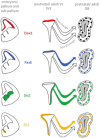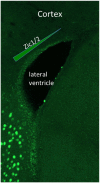Neuronal Subtype Generation During Postnatal Olfactory Bulb Neurogenesis
- PMID: 29511358
- PMCID: PMC5833171
- DOI: 10.1177/1179069518755670
Neuronal Subtype Generation During Postnatal Olfactory Bulb Neurogenesis
Abstract
In the perinatal and adult forebrain, regionalized neural stem cells lining the ventricular walls produce different types of olfactory bulb interneurons. Although these postnatal stem cells are lineage related to their embryonic counterparts that produce, for example, cortical, septal, and striatal neurons, their output at the level of neuronal phenotype changes dramatically. Tiveron et al. investigated the molecular determinants underlying stem cell regionalization and the gene expression changes inducing the shift from embryonic to adult neuron production. High-resolution gene expression analyses of different lineages revealed that the zinc finger proteins, Zic1 and Zic2, are postnatally induced in the dorsal olfactory bulb neuron lineage. Functional studies demonstrated that these factors confer a GABAergic and calretinin-positive phenotype to neural stem cells while repressing dopaminergic fate. Based on these findings, we discuss the molecular mechanisms that allow acquisition of new traits during the transition from embryonic to adult neurogenesis. We focus on the involvement of epigenetic marks and emphasize why the identification of master transcription factors, that instruct the fate of postnatally generated neurons, can help in deciphering the mechanisms driving fate transition from embryonic to adult neuron production.
Keywords: Neural stem cells; olfactory bulb; transcription factor.
Conflict of interest statement
Declaration of conflicting interests:The author(s) declared no potential conflicts of interest with respect to the research, authorship, and/or publication of this article.
Figures


Comment on
- J Exp Neurosci. 3888.
References
-
- Merkle FT, Mirzadeh Z, Alvarez-Buylla A. Mosaic organization of neural stem cells in the adult brain. Science. 2007;317:381–384. - PubMed
-
- Azim K, Hurtado-Chong A, Fischer B, et al. Transcriptional hallmarks of heterogeneous neural stem cell niches of the subventricular zone. Stem Cells. 2015;33:2232–2242. - PubMed
-
- Beckervordersandforth R, Tripathi P, Ninkovic J, et al. In vivo fate mapping and expression analysis reveals molecular hallmarks of prospectively isolated adult neural stem cells. Cell Stem Cell. 2010;7:744–758. - PubMed
LinkOut - more resources
Full Text Sources
Other Literature Sources

